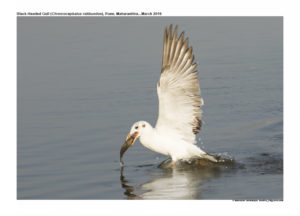Black-headed Gull

Black-headed Gull Chroicocephalus ridibundus
Etymology :
- Chroicocephalus : Greek word khroizo– to colour, to stain; kephalos -headed
- Ridibundus : Latin word for Laughing derived from ridere to laugh
Vernacular Name: Hindi: Kal-siri gangachilli, Kala Dhomra, Sans: Kalshirsh gangachilli, Pun: Kalasir-damra, Guj: Kala mathano dhomdo, Shayamashir dhomado, Mar: Kurvak, Kalya dokyacha kurav, Te: Gourukaki
Distribution in India: Widespread Winter visitor in India.
Description: Size of 37–44 cm; wt. of 195–325 g; wingspan of 91–110 cm.. The breeding adult has the frontal hood dark chocolate brown to dusky blackish, with blackish border; white eye-crescents, mainly behind eye; neck white; underparts white, upperwing-coverts, secondaries and inner primaries grey, secondaries with white tips; outer primaries white, edged and tipped black; tail white; bill and legs dark red; eye dark brown. Non-breeding adult has white head, but retains a dusky spot on ear-coverts and some blackish clouding on nape.Both the sexes look similar. The juvenile has extensive rich buff to darker brown markings on upperparts and upperwing-coverts; black terminal band to tail; bare parts are duller. First-winter birds combine an adult-type head and body with juvenile-type wings and tail; the dark-centred tertials are particularly distinctive on settled birds. First-summer develops a variable dark hood, duller than in adults, and retains the first-winter plumage, which becomes progressively bleached and worn. Second-winters resembles adult winter but some show complete black webs to the outer 1–2 primaries and occasionally dark spots on the primary-coverts, alula, tertials and tail.
Habitat: It is found in temperate zone to edge of boreal forests of Palearctic; mainly at low altitudes, and generally near calm, shallow water of coastal or inland waters, including rivers and their estuaries. Chiefly an inland breeder, with much breeding habitat created by rising water levels, and colonies eventually abandoned when water levels fall and leave dry basin; in many places, however, nests on relatively dry sites, like moors, sand dunes and beaches. In winter, tends to occur far more in coastal habitats, but also inland at relatively low elevations. Commonly found in harbors and around sewage outfalls. Seldom far offshore, except on passage. It frequents pastures and farmland, including rice fields, flocks often following the plough. Very large numbers are attracted with other gulls to landfill rubbish dumps.
Food Habits: It eats aquatic and terrestrial insects as well as earthworms during breeding season. Feeds by swimming and seizing objects from surface, or dipping head under surface; along coast, by walking on mudflats and probing for shrimps and marine worms; sometimes by foot-stirring and foot-paddling. Also follows fishing boats and ferries that churn up food items, and may feed at night. Plant material is taken opportunistically: it includes fruits and seeds from trees and shrubs in summer in autumn; for example, olives, figs and acorns, and cereal grain from autumn stubble or spring sowings. Frequently kleptoparasitic on Northern Lapwings and Eurasian Golden Plovers feeding on pastures, where it steals earthworms; also robs Lapwings and other waders on mudflats. In non-breeding season, relies heavily on various artificial food sources provided by man, ; following fishing boats near harbors, frequenting sewage outfalls, taking scraps in parks and feeding at landfill rubbish dumps.
Breeding Habits: They breed in March- June in Europe. It is a colony breeder and makes a nest that is usually close together. The nest is made of masses of plant stems; large, bulky nests built in marshes, smaller nests on land. They lay a clutch of 1-3 eggs. The incubation is done by both sexes, either equally or with female doing more of the work for a period of 22-26 days. The fledging period is 33-35 days.